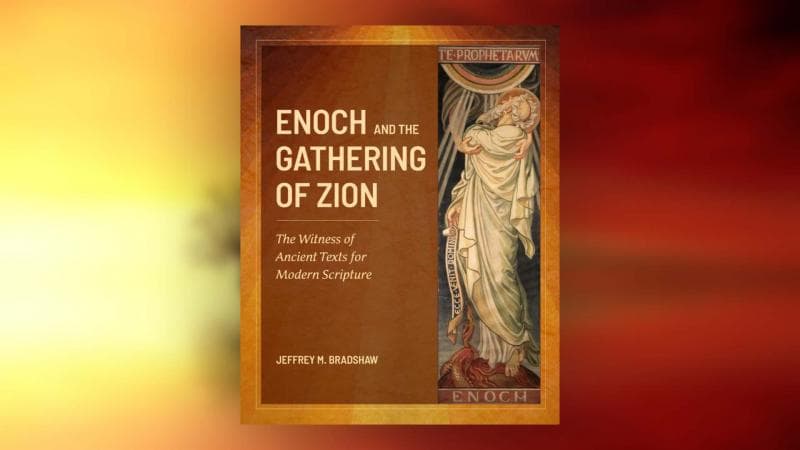February 23, 2022
Book Review: Enoch and the Gathering of Zion
Post contributed by
Ryan Dahle

Those following the Come Follow Me reading schedule for 2022 recently encountered the story of Enoch in Moses 6–7. These chapters, translated by Joseph Smith in 1830, considerably expand upon the biblical description of Enoch, which comes from just a few short passages in the Old and New Testaments (Genesis 5:19–24; Hebrews 11:5; Jude 1:14–16). What many readers may not know is that numerous traditions and legends surrounding the prophet Enoch have been preserved in a variety of ancient documents.
While such traditions undoubtedly contain the “interpolations of men,” they also may preserve “many things … that are true”—much like the apocryphal texts that Joseph Smith asked about in 1833 (D&C 91:1–2). This opens up all sorts of exciting research possibilities that can add to our understanding of Enoch and his ministry. Accessing and comprehending this extrabiblical information, however, is no easy task. Many of us likely wouldn’t even know where to begin. Which is where a recent book written by Jeffrey M. Bradshaw may come in handy. It’s called Enoch and the Gathering of Zion: The Witness of Ancient Texts for Modern Scripture (referred to hereafter simply as Enoch and the Gathering).
In his book, Bradshaw first introduces readers to the development of Enoch studies in modern times, including the discovery and publication of important texts like 1 Enoch, 2 Enoch, 3 Enoch, and the Book of Giants. These and other documents—which come from diverse times, languages, and textual traditions—contain a wealth of information about Enoch and his ancient cultural setting.
What is so remarkable is the way the account in Moses 6–7 so often agrees with themes and details (sometimes very specific details) contained in these extrabiblical sources. Bradshaw ably guides readers through these manifold relationships. In some cases, they offer intriguing evidence of Joseph Smith’s prophetic calling. As a case in point:
Readers of the Book of Moses have often puzzled over Enoch’s self-description as a “lad” (Moses 6:31), especially since he as at least sixty-five years old at the time (v. 25). Strikingly, this is the only instance of the term “lad” in the teachings and revelations of Joseph Smith. Hugh Nibley was the first to recognize its significance, given the prominence of “lad” (or the equivalent term “youth”) as a name for Enoch in several Jewish mystical works, including the pseudepigraphal books of 2 Enoch and 3 Enoch. Joseph Smith could not have encountered these books. (p. 41)
Such connections not only help establish the genuine antiquity of the Book of Moses, but they also suggest that at least some of the details in these extrabiblical sources are accurate.
In other cases, Enoch and the Gathering draws out connections that help enrich and inform our understanding of key Restoration doctrines. This is illustrated well in Bradshaw’s discussion of the baptism and ritual ascent of Adam and Eve (Moses 6:64–68; 7:1), which is also spoken of in Islamic, early Christian, Mandaean, and Manichaean traditions. As Bradshaw walks readers through the ritual ascent motifs found in these ancient traditions (pp. 81–83), it is hard not to gain a better appreciation and understanding of restored doctrines and rituals pertaining to Latter-day Saint temple worship.
While the content of Enoch and the Gathering necessarily delves into arcane texts, traditions, rituals, languages, art, and so forth, it is written in a fairly accessible style. It seems intended to introduce lay readers to scholarly information about Enoch without completely drowning them in a deluge of obscure data, much of which has been relegated to the book’s more than 1000 endnotes (when the epilogue and appendix are included). All in all, the book strikes a decent balance of being accessible, informative, and well sourced.
While many of Bradshaw’s discussion points have been addressed in his earlier publications, Enoch and the Gathering contains a number of updates. As explained in its preface, the book largely draws upon information from concurrent research projects, including the following:
- Book of Moses essays from Pearl of Great Price Central,
- a series of articles recently published in Interpreter: A Journal of Latter-day Saint Faith and Scholarship,
- results from recent conferences entitled Tracing Ancient Threads in the Book of Moses (held in 2020 and 2021),
- and a commentary called Old Testament Minute prepared for ScripturePlus (a scripture app provided for free by Book of Mormon Central).
Thus, in addition to its own novel contributions, Enoch and the Gathering of Zion provides a helpful synthesis of recent Enoch-related research. For anyone interested in an up-to-date treatment of the life and ministry of one of the greatest prophets of the ancient world, this book is a great place to start.